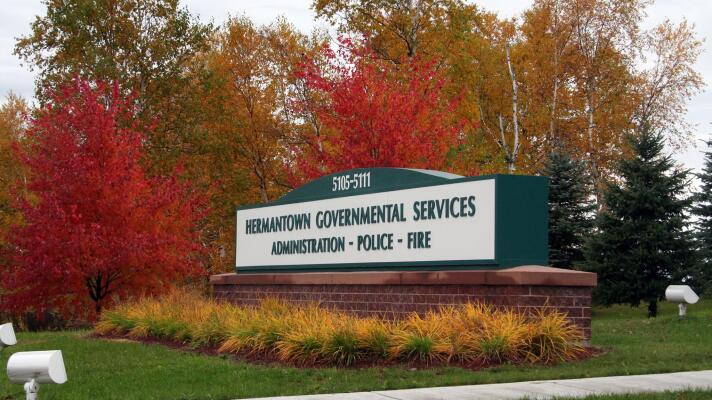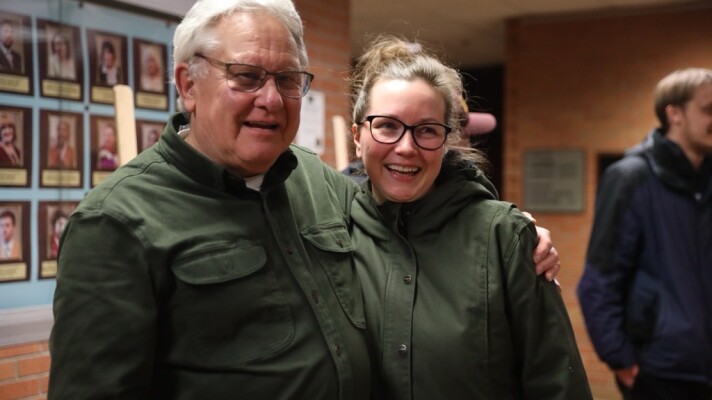EMILY — A third-party study of a potential manganese mine in Emily shows the operation could make back its investment in less than two years.
The preliminary economic assessment justifies moving forward with the next steps for North Star Manganese, the company with its sights on what would be the only commercial manganese mining operation in North America. CEO Rick Sandri presented the findings Nov. 12 to the Emily City Council and an overflow crowd of people at Emily City Hall.
“It is a slow, meticulous process. We’re not doing it like a fast rush,” Sandri said. “This is hard science that we have to do, and it takes a long time, and there’s a lot of questions.
“We also need to be able to have dialogue with the city and the people in the community, because I'm sure there are 1,000 questions. And at some point, we want every one of those questions listed down, so we can answer them properly.”

Skeptical Council members, crowd
Many questions center on concerns about how mining might impact drinking water quality and the pristine environment of forests and lakes.
For those at city hall, the presentation was yet another update on a project that’s been under consideration for at least 17 years. Council members reminded Sandri of broken promises and failures to follow up before North Star Manganese’s involvement, and the audience interjected repeatedly with that sentiment throughout the hourlong discussion.
“As you can see, Rick, there's a lot of [skepticism] here. I'm one of them — very skeptical,” said Gary Hanson, a Council member for 30 years. “ ... I pray to God that you're very transparent with us, what you're saying. I think it's so important, the water quality here.”
North Star Manganese has not taken any steps at this time to propose a mining project to state agencies. The company halted its exploratory drilling, having confirmed what it believes to be at least 23 years' worth of resources at the site, according to the analysis.

The next steps, Sandri explained, include proceeding to pre-feasibility and feasibility studies for an underground mine in Emily spanning a half-square-mile and an accompanying chemical processing plant in an as-yet-undetermined location in the United States. This means a lot more data collection and analysis, along with beginning discussions with trade unions and initiating permitting with state regulators and federal agencies. The company also needs to find manufacturers interested in buying its product.
“We graduated from kindergarten. We completed our Phase One work that says, ‘You actually have something here and there,’ versus what other people might have said, [when] it’s been smoke and mirrors,” Sandri said.
“We’ve drilled it. We’ve spent millions of dollars. We think there’s something here of merit. Can it be turned into something? ... Can it be done correctly? Those are all questions we need to answer.”
Why manganese and why now
Some of the first exploratory drilling in Emily occurred decades ago, in the late 1940s and early 1950s. Various drilling efforts by different mining companies — including in 2023 by North Star — gave insight into what’s locked deep below the earth: billions of pounds of rich manganese ore.
An accelerated push toward clean energy alternatives and a growing market for electric vehicles and other battery-powered technologies reignited interest in the site’s potential. Manganese is one of the metals used in battery production, combined with nickel and cobalt to increase energy storage capacity.

While the element is one of the most plentiful on the planet, a small sliver appears to be pure enough for battery use. And signs so far point to Emily’s deposit containing that high-quality ore.
Through a wholly owned subsidiary Cooperative Mineral Resources, Crow Wing Power purchased some of the property containing the ore in 2008 with the intention of finding partners to develop its mining prospects. If the mine moves forward, it would be the only such operation on the continent in a marketplace where most of the mining is happening in Africa and processing in China.
The preliminary economic assessment predicts the mine lifespan would be at least 23 years, producing 400,000 tons of manganese annually. The mine and processing plant would require $474.8 million in initial capital investment, with another $150 million set aside for plant expansion and $276 million for sustaining and closure costs. The high-grade manganese would fetch $2,500 per ton, once converted to manganese chemicals for commercial use.

Impacts on Emily
Emily City Council member Dan Brennan said he read the assessment top to bottom. He said it covered the financial implications for the company but failed to contemplate impacts on the community.
“Not one thing in there in terms of the cost of this project is anything having to do with the city or its residents,” Brennan said. “And in the meantime, you continue to work out there. You continue to work around the water source that everybody's so concerned with, and we are left to hope that you get there soon.”
Brennan was elected to the Council in 2024 but has long been involved with the Emily Mining Information Group, a citizen organization researching various aspects of the proposed project. The group took on its own water well testing, funded by grants and private donations, to establish a baseline.
“I don't understand why you can't proceed now ... to start either contributing to our process or starting your own to ensure that our water is protected,” Brennan said. “This ‘we’re planning to plan’ thing seems long overdue.”
Sandri said he understood the concerns and emphasized there were many more steps to complete along the way.
“Our job for our company was to determine whether we actually had a viable project to continue activity on,” he said. “ ... As a corporation, we believe we have met that internally to allow us to spend more money.”
He said at this preliminary stage, he couldn’t yet describe exactly how water testing would go and when it might happen.

“We're going to start looking at all of the things we have to do … so that will probably involve taking samples, analyzing things along that line,” Sandri said. “But a lot of it is due to our own project, because we have water needs, water requirements. And also we want to make sure that we are not doing anything affecting city water, resident water.”
Mayor Tracy Jones asked Sandri to explain in the simplest terms possible what the benefits would be for Emily residents. Sandri noted the city would receive cash payments per ton of material, and taxes would be collected by the county, state and federal governments that would come back to the city in one form or another.
Currently, mining of nonferrous minerals — like manganese, copper and nickel — is not happening in Minnesota. But if operations were to gain approval, they would be subject to several taxes, with the revenue distributed according to state statute. Emily would directly receive 5% of the tax proceeds. Crow Wing County and the Crosby-Ironton School District would each receive 10%. The remaining revenue is split between several other funds, like 20% to the Regular School Fund and 20% to the Department of Iron Range Resources and Rehabilitation, from which the local governments may also benefit.
Sandri said the mine would provide about 100 jobs with high wages, including mining jobs ranging from $120,000 to $140,000 per year and administrative positions.
“There may be an advantage to some people on real estate. There may be a disadvantage to some people on real estate. Depends if you're a buyer or a seller or a renter,” Sandri said.
“We will be utilizing local services and supplies. That’s 25 years of people, you know. Twenty-five years of activity here that people will be buying from the Ace [Hardware], ... going to local restaurants and things of that sort.”
Hanson replied, “Well, Rick, you’ve got to keep in mind: No amount of money replaces what we have here.”
Sandri said he views this project as his parting legacy in a long career, and it’s important to him to get it right.
“I'm an environmentalist that's in the mining industry. I believe that things need to be done correctly to be able to utilize the assets that God gave us on this planet,” Sandri said. “But I believe we should utilize the assets. So, I come from that side, the use.
“And I don't want it to be my reputation, or on my tombstone, that I caused issues at Emily. That's not what I'm looking for.”

Next steps with the state
One of the steps in progress for North Star Manganese is to gain mineral rights leases on several state-owned properties surrounding those it has already explored. It’s the only pending request before the Minnesota Department of Natural Resources, and it has yet to be recommended by the DNR to the state’s Executive Council since public input was collected in October 2021.
Sandri told the City Council the company is seeking these leases with the intention to use the property as a visual buffer for the future mining operation, not to expand the mining footprint. Brennan asked Sandri why this approval hasn’t moved forward.
“We have been told that they would like to see the city of Emily neutral to positive on the event. They would like to see the county of Crow Wing neutral to positive on the event,” Sandri said.
“They were hoping that the letter writing associated with some disgruntled parties affiliated with the old CMR [Cooperative Mineral Resources]-Crow Wing [Power] situation would have been settled. To my understanding, they're not. ... So, the DNR is taking an extremely standard governmental cautious approach of not doing anything until something needs to be done.”

In a statement to KAXE, the DNR acknowledged it has not decided whether to recommend approval of the lease request. If the leases were approved, any revenue generated from them would benefit the local community, county and schools.
“The DNR will continue to work with these beneficiaries and others to understand their perspectives on this lease request,” according to the statement.
The DNR further stated the City Council meeting “highlighted a need for additional context on the status of NSM’s work.”
If the company opts to proceed beyond the exploration stage, establishing a mine plan involves extensive work to collect critical baseline environmental data.
“If submitted, the proposal would go through extensive regulatory review, including the preparation of a mandatory environmental impact statement and several permitting decisions,” the DNR stated.
“The mining environmental review and permitting processes involve multiple public engagement opportunities with a variety of state agencies. These processes typically take years before final environmental review and permit decisions are made.”
-
Plus: MnDOT will host an open house on its Highway 34 corridor study in Park Rapids; and a state task force is hosting three public input sessions to gather information on how Minnesotans forage on state lands.
-
The Minnesota Forestry Association hosted the first of two webinars focused on reforesting the Bemidji area after millions of trees blew down in the June 21, 2025, windstorm.
-
Former Mesabi East math teacher Ryan Ross Denzer-Johnson entered a plea agreement with St. Louis County prosecutors after being initially charged in August 2025.
-
Paul Bunyan Communications estimates that services will be available in all project areas by the end of January.
-
The new contract will cover the almost 300 nurses who work for Essentia in the Brainerd lakes area for the next three years.
-
The city wants the public to help inform the development of the 160-acre park, with the goal of maximizing its potential use.
-
Grand Rapids, Mahnomen/Waubun, Fertile-Beltrami and Kittson County Central will play Nov. 13-15, at U.S. Bank Stadium in Minneapolis in the 2025 state football semifinals.
-
And: Grand Rapids reimagining Legion Park; Paul Bunyan Communications offers timelines on Itasca, St. Louis county projects; and Northland teams prepare for state football semifinals.
-
Separate from the Highway 71 corridor study, this visioning effort will identify longer-term goals and other potential improvements, like pedestrian crossing needs.
-
The order directs the Minnesota Department of Veteran Affairs to coordinate the effort to address food insecurity for veterans and their families.





































